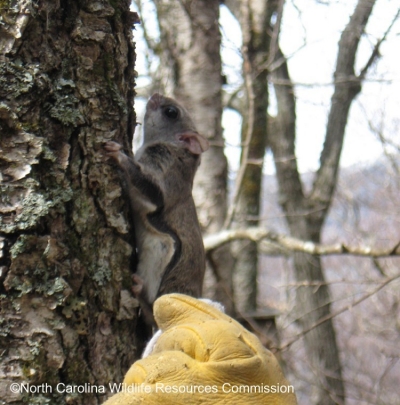Southern Flying, Squirrel Glaucomys volans
The Southern Flying Squirrel is a nocturnal rodent, occurs state-wide and is Tennessee's smallest tree squirrel.
Description: A small tree squirrel containing a very soft, grayish-brown fur coat with a blackish undercoat (shown when hairs parted) and a white belly (hairs are white to the base). They have large black eyes and their tail is flattened. A distinctive loose fold of skin, the flying membrane, occurs on each side of the body extending from the outside of the wrist on the front leg to the ankle on the hind leg. A spur, made of cartilage, extends outward from the front wrists to support the flying membrane. There are 4 clawed toes on the front foot and 5 on the back.
Length: 8.0 - 11.3 inches
Tail: 3.1 - 5.1 inches
Ears: 0.6 - 1.0 inches
Weight: 1.5 - 5.0 ounces
Similar Species: Northern Flying Squirrel is larger and belly hairs are gray at the base.
Habitat: Generally prefers mature oak-hickory forests near water and containing plenty of snags with cavities. They may also live in forests near human houses, sometimes living in attics or birdhouses.
Diet: Prefers hickory nuts and acorns, but also eats fruits, berries, corn, tree buds, insects and bird eggs and nestlings.
Breeding information: Southern Flying Squirrels generally breed twice a year, in the late winter and mid-summer. Gestation lasts 40 days, so litters are born from March to April and from July to September. Litter sizes range from 1-6 young with an average of 3-4. The young flying squirrels nurse for about 5 weeks before they are weaned. They will remain with their mother until her next litter.
Status in Tennessee: No protection for the Southern Flying Squirrel as they can be plentiful in some forested habitats.
Fun Facts:
• Flying squirrels do not actually fly. They launch from a tree, or other high point, and glide downward to another tree or the ground.
• Once flying squirrels land on a tree they immediately dash to the other side to avoid a predator, which may have followed its flight.
Best places to see in Tennessee: Mature oak-hickory forests containing plenty of snags with woodpecker holes.
